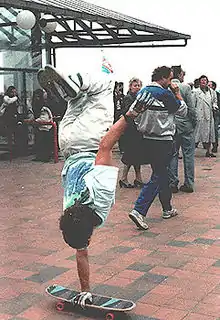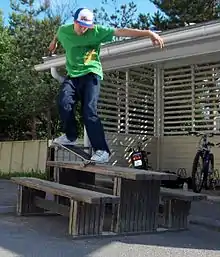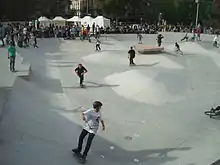Skateboarding styles
A skateboard style refers to the way a skateboarder prefers to ride a skateboard. Skateboard styles can be broadly divided into two different categories: skateboarding to perform tricks and skateboarding as a means of transportation. Styles of skateboarding have evolved over time and are influenced by a number of factors including sociocultural evolution, mass media, music, technology, corporate influence and individual skill level.[1]

The styles used by different skateboarders when riding skateboards should not be confused with skater style, the manner in which skateboarders dress or act in relation to skateboarding culture.
Styles
Freestyle Skateboarding

Probably the oldest style of skateboarding, freestyle skateboarding developed from the use of skateboards as a mode of transport in the 1960s. Professional freestyle competitions often involved music and choreography and focused on fluidity and technical skill. The style changed significantly with the introduction of ollies and other tricks in the 1980s and the introduction of various obstacle elements.[2]
Vert Skateboarding
Vert skateboarding has its genesis in "pool riding" - the riding of skateboards in emptied backyard swimming pools - during the 1970s.[1][2] It involves skateboard riders moving from the horizontal (on the ground) to the vertical (on a ramp or other incline) to perform tricks - thus "vert".[3] It is also referred to as "transition skateboarding" or "tranny skating". Skateboarders usually set-up their boards with 55mm (or larger) wheels and wider decks for more stability.[2][4]
Street Skateboarding

Street skateboarding involves the use of urban obstacles like stairs and their handrails, planter boxes, drainage ditches, park benches and other street furniture.[2] Skaters perform tricks around, on, onto or over these obstacles.[5] Skateboarders usually set-up their boards with 55mm (or smaller) wheels and narrower decks to make the board flip and spin faster and to make performing tricks easier.[2][4]
Park Skateboarding

Park skateboarding encompasses a variety of sub-styles adopted by those who ride skateboards in purpose-built skate parks. Most skate parks combine halfpipes and quarterpipes with various other "vert" skateboarding features as well as "street" obstacles such as stairs and rails. The integration of these elements produces a different skating experience.[6]
Cruising
Skateboarding done with any type of skateboard where riders travel as fast as possible on ramps and through skate parks or through general urban areas without tricks for as long as possible without stopping or touching surfaces. Skateboarders in this category often use "cruisers" which are generally wider and have rubbery wheels. Cruising, similarly to Downhill Skateboarding, is often used for transportation. This style is a choice for skaters who want something in-between longboarding and skateboarding.
Downhill Skateboarding

Non-competition downhill skateboarding is one of the oldest styles of skateboarding and was popular in the early 1970s. Original longboards were described as being like snow skis (in terms of length).[2] Modern riders often use longboards for races, but some use regular skateboards for non-competition downhill skateboarding.
Other Styles
- Big Air Skateboarding was invented when Danny Way and DC Shoes created the "Mega Ramp", with a giant "roll in" for speed followed by a large launch ramp, a (approximately) 50 foot gap and a (approximately) 25 foot quarterpipe. It has recently become popular enough to be an event in the X-games, and they are now adding other obstacles such as rails in the gap.
- Technical flatground skateboarding - also referred to as Tech Skateboarding and Flatlanding.[5] Those who skateboard in this style are referred to as Flatlanders, Skateboarding Technicians, Technical Skateboarders'.
- "Stunt Kook Skateboarding" (Also Known as Parkour Skateboarding) is a type of street skating in which the rider designs stunts to be done on his/her board, such as launching off large buildings, switching boards mid-flight, or even jumping down stairs.
- Grass surfing
References
- Loveletters To Skateboarding: Style by Blair Alley. Posted in Transworld Skateboarding on 31 August 2012 (video)
- The Science and Art of Skateboard Design: How Boards Have Changed Over Time (Exploratorium)
- Vert Skating: Mastering the Ramp by Jeff Savage (Capstone, 2005)
- Skateboard Guide and Skate Size Chart (Evo.com)
- Different Kinds of Skateboarding by Philip Foster (Livestrong Foundation, 29 April 2012)
- Skateboarding, Space and the City: Architecture and the Body by Iain Borden (Berg, 2003)